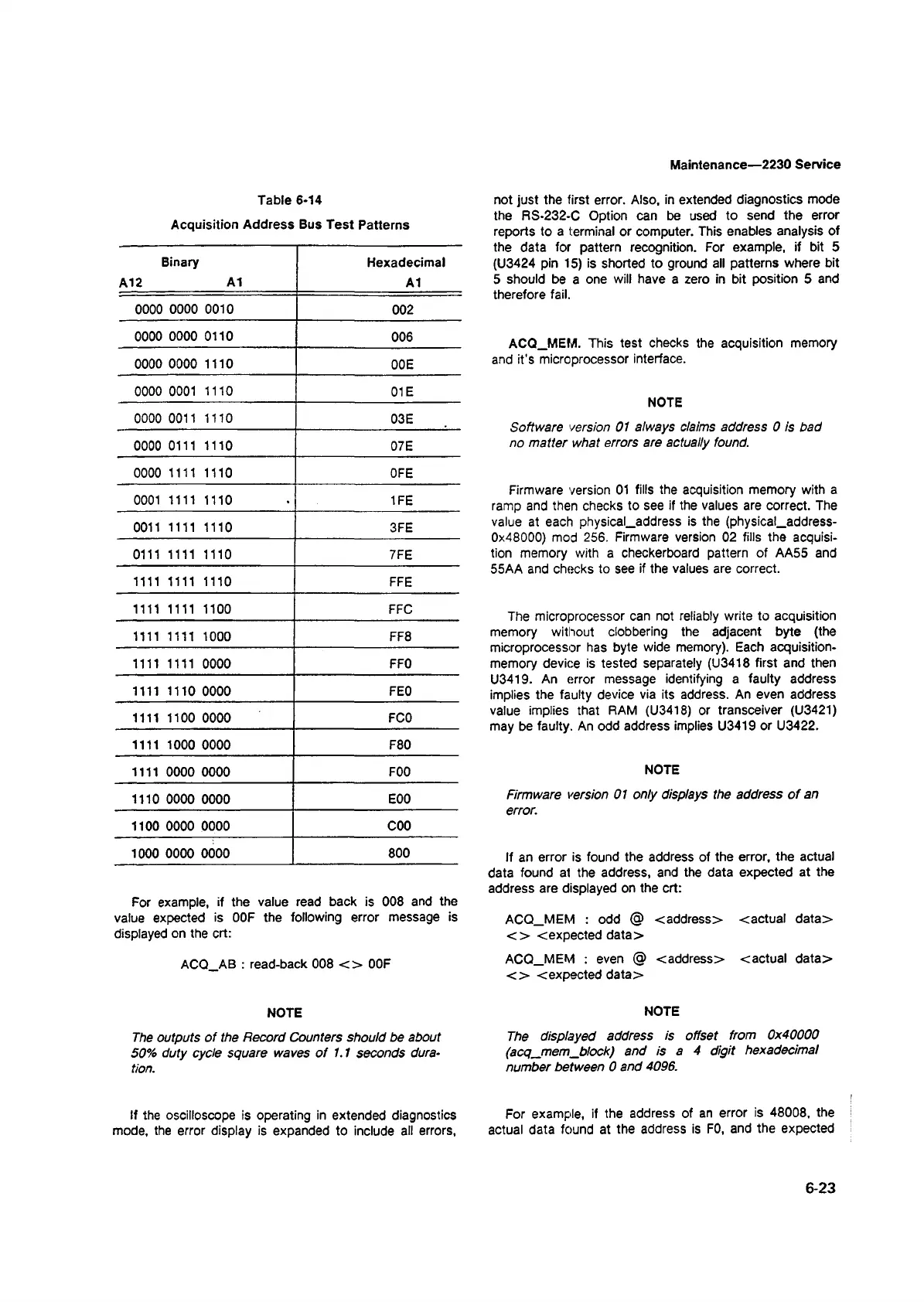Maintenance—2230 Service
Table 6-14
Acquisition Address Bus Test Patterns
Binary
A12 A1
Hexadecimal
A1
0000 0000 0010
002
0000 0000 0110
006
0000 0000 1110
00E
0000 0001 1110
01E
0000 0011 1110
03 E
0000 0111 1110 07E
0000 1111 1110
0FE
0001 1111 1110
1FE
0011 1111 1110 3FE
0111 1111 1110
7FE
1111 1111 1110
FFE
1111 1111 1100
FFC
a l
_ *
o
o
o
FF8
1111 1111 0000 FF0
1111 1110 0000 FE0
1111 1100 0000 FC0
1111 1000 0000
F80
1111 0000 0000 F00
1110 0000 0000
E00
1100 0000 0000 COO
1000 0000 0000
800
For example, if the value read back is 008 and the
value expected is OOF the following error message is
displayed on the crt:
ACQ AB : read-back 008 < > OOF
NOTE
The outputs of the Record Counters should be about
50% duty cycle square waves of 1.1 seconds dura
tion.
If the oscilloscope is operating in extended diagnostics
mode, the error display is expanded to include all errors,
not just the first error. Also, in extended diagnostics mode
the RS-232-C Option can be used to send the error
reports to a terminal or computer. This enables analysis of
the data for pattern recognition. For example, if bit 5
(U3424 pin 15) is shorted to ground all patterns where bit
5 should be a one will have a zero in bit position 5 and
therefore fail.
ACQ_MEM. This test checks the acquisition memory
and it's microprocessor interface.
NOTE
Software version 01 always claims address 0 is bad
no matter what errors are actually found.
Firmware version 01 fills the acquisition memory with a
ramp and then checks to see if the values are correct. The
value at each physical_address is the (physical_address-
0x48000) mod 256. Firmware version 02 fills the acquisi
tion memory with a checkerboard pattern of AA55 and
55AA and checks to see if the values are correct.
The microprocessor can not reliably write to acquisition
memory without clobbering the adjacent byte (the
microprocessor has byte wide memory). Each acquisition-
memory device is tested separately (U3418 first and then
U3419. An error message identifying a faulty address
implies the faulty device via its address. An even address
value implies that RAM (U3418) or transceiver (U3421)
may be faulty. An odd address implies U3419 or U3422.
NOTE
Firmware version 01 only displays the address of an
error.
If an error is found the address of the error, the actual
data found at the address, and the data expected at the
address are displayed on the crt:
ACQ_MEM : odd @ <address> <actual data>
< > <expected data>
ACQ_MEM : even @ <address> <actual data>
< > <expected data>
NOTE
The displayed address is offset from 0x40000
(acq_mem_b!ock) and is a 4 digit hexadecimal
number between 0 and 4096.
For example, if the address of an error is 48008, the
actual data found at the address is F0, and the expected
6-23
